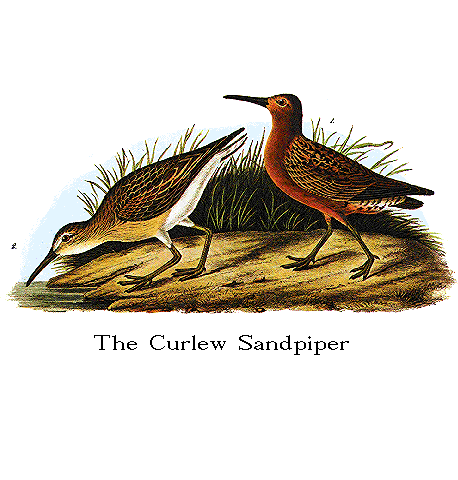Birds of America
By John James Audubon, F. R. SS. L. & E.
VOLUME V.



Family
Genus

THE CURLEW SANDPIPER.
[Curlew Sandpiper.]
TRINGA SUBARQUATA, Temm.
[Calidris ferruginea.]

PLATE CCCXXXIII.--ADULT AND YOUNG.
In the course of my extensive rambles along our coasts and in the interior,
I have seen only three birds of this species, all of which I have kept with
care, considering the Cape Sandpiper or Pigmy Curlew as the rarest of its genus
with us. It appears to resort to particular districts; two of my birds were
shot at Great Egg Harbour in New Jersey, in the spring of 1829, the other on
Long Island near Sandy Hook. No other birds were near them, and I approached
them without much difficulty. They were wading along the shores up to the
knees, picking up floating garbage and sand-worms. In their stomachs I found
fragments of minute shells, slender red worms, and bits of marine plants. The
one killed on Long Island was a fine male in full plumage, and from it I made
the figure that has been engraved in the plate. The others were females or
young birds of the preceding year. One, in plain plumage, was drawn; the other,
mottled beneath with patches of white and dull rufous, I considered as a female
which might perhaps have perfected its colouring that season. I have seen a few
specimens in New York, and two in Boston; and my friend JOHN BACHMAN has one or
two in his possession.
TRINGA SUBARQUATA, Bonap. Syn., p. 317.
CAPE CURLEW or SANDPIPER, Nutt. Man., vol. ii. P. 104,
CURLEW SANDPIPER, Tringa subarquata, Aud. Orn. Biol., vol. iii. p. 444.
Accidental on the Florida coast in winter, rare on those of the middle
districts. Breeds in high latitudes. Migratory.
Adult Male.
Bill longer than the head, slender, subcylindrical, flexible, very slightly
decurved, compressed at the base, the point obtuse. Upper mandible with the
dorsal line at first slightly sloping, then nearly straight, and towards the end
slightly decurved, the ridge convex but narrow, the sides sloping, the edges
rather blunt and soft. Nasal groove extending to near the tip; nostrils basal,
linear, pervious. Lower mandible with the angle long and very narrow, the
dorsal line straight, the sides nearly erect, with a long narrow groove, the tip
tapering but rounded.
Head of moderate size, oblong, compressed. Eyes of moderate size. Neck of
moderate length, rather slender. Body rather slender. Feet rather long,
slender; tibia bare about a third of its length; tarsus compressed, anteriorly
and posteriorly covered with numerous scutella; hind toe very small; the rest of
moderate length, slender, the fourth a little longer than the second, the third
longest, all free, scutellate above, flat beneath, slightly marginate; claws
small, slightly arched, compressed, acute, that of third toe largest, with the
inner edge slightly dilated.
Plumage very soft, blended beneath, slightly distinct above. Wings long
and pointed; primaries tapering, obtuse, the first longest, the second scarcely
shorter, the rest rapidly graduated; outer secondaries short, incurved,
obliquely truncate, the inner web extending beyond the outer; the inner
secondaries elongated, tapering. Tail rather short, slightly rounded, of twelve
rounded feathers, the two middle a little longer.
Bill dark olive-green, dusky towards the point. Iris hazel. Feet light
olive, claws dusky. The head, neck and breast are bright yellowish-red, the
sides whitish, the lower tail-coverts white, with a brownish-black spot towards
the end. The central parts of the feathers on the upper part of the head are
dark brown, and there are slight streaks of the same on the hind neck and sides
of the breast. The upper parts are mottled with brownish-black and dull red,
the rump pale brownish-grey, as are the smaller wing-coverts. Quills
greyish-brown, the primaries dark, the outer secondaries light and tipped with
white, the inner darker and glossed with green. Upper tail-coverts white,
spotted with brown and red; tail pale brownish-grey, glossed with green.
Length to end of tail 8 3/4 inches, to end of wings 9 2/12; extent of wings
16; wing from flexure 5; tail 2 2/12; bill along the back 1 1/2, along the edge
of lower mandible 1 5/12; bare parts of tibia 1/2; tarsus 1 1/12, middle toe 1,
its claw 2/12. Weight 2 1/4 oz.
Adult Female.
The bill, iris, and feet as in the adult. On the upper parts the feathers
are brown, edged with darker, and margined with greyish-yellow; the lore, cheeks
and sides of the neck and body are greyish-yellow, with dusky lines; a broad
band from the mandible over the eye, the fore part of the neck, and the rest of
the lower parts, white. Quills and tail as in the adult, but lighter.
Length to end of tail 7 3/4 inches; extent of wings 14 1/2. Weight 1 3/4
oz.









